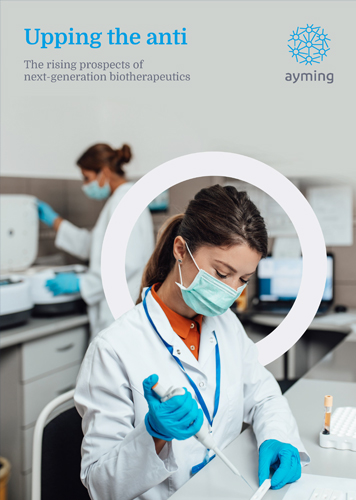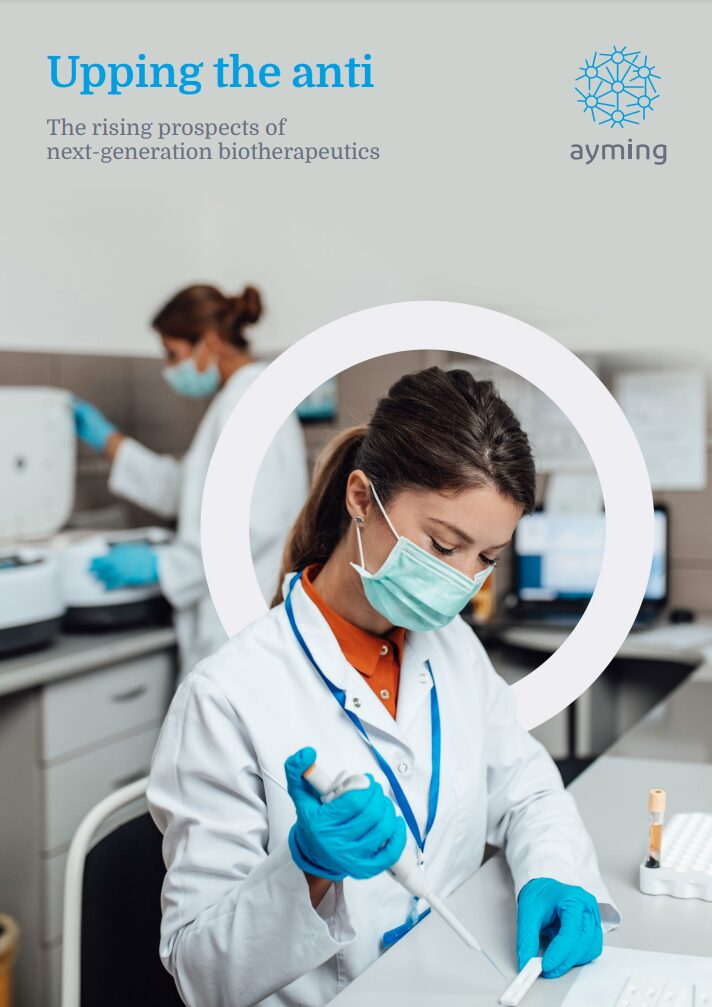
Table of contents
Executive Summary
After the public health cataclysm of 2020, the importance of pharmaceutical R&D – and arming the body’s immune system, in particular – has never loomed so large. For the field of antibody research, this surge of interest is not so much a necessary shot in the arm as a booster for a vigorous field of high promise.
As rapid success with vaccines and monoclonal antibody therapeutics against Covid-19 works wonders for Big Pharma’s image, scores of actors large and small are striving to advance antibody technologies and therapies, in the UK and internationally.
The pandemic has given the public a biology lesson in the power of antibodies – proteins produced by the immune system in response to exposure to a toxin, allergen or infectious disease. Once produced during initial exposure, these antibodies remain in circulation through the blood and lymph vessels and bind the same foreign proteins should re- exposure occur, speeding up the body’s immune response.
History of antibodies
The role of antibodies in treating human diseases was first discovered in the late 19th century when Emil von Behring observed that plasma of horses previously exposed to diphtheria could be used to treat the infection in humans. This observation was deemed so important that he was awarded the first Nobel Prize in physiology or medicine, in 1901.1
It was in the mid-1970s that modern antibody research took off with full understanding of the atomic structure of antibody fragments and the invention of monoclonal antibodies.2 Monoclonal antibodies (mAbs) recognise only one specific protein structure, making them extremely useful in targeted drug therapy, diagnostics and research.
Antibodies produced by humans and animals, when isolated and purified, are a powerful tool essential to every kind of molecular analysis. Antibodies are used to identify biological markers in blood, giving the ability to answer research questions that cannot be replicated by any other technology.
Therapy’s ‘magic bullets’ hit their first target in 1986 when the OKT3 (muromonab) immunosuppressant drug was approved to treat transplant rejection.3 But it was the 1990s before therapeutic antibodies became one of the fastest- growing classes in the biological drugs market.4


Markets & brands
Now they are dominant in pharmaceuticals, with global mABs sales predicted to exceed $200 billion in 2024.5 The biggest sellers treat cancer or auto-immune disease.
First licensed in the US in 1998, Roche’s Herceptin (trastuzumab) attaches to HER2 receptors to stop breast and stomach cancer cells dividing.6 Commonly used in immunotherapy for a range of cancers, Merck and Co’s Keytruda (pembrolizumab) activates T-cells by blocking PD-1 protein on their surface.7
Investors are backing a clutch of smaller UK companies to develop new cancer treatments, spurring R&D activity (see box). Adaptate Biotherapeutics is targeting gamma delta T-cells to harness the selectivity of adaptive immune response.8 Celleron Therapeutics is focusing on combination cancer therapies, and has several drugs in phase I trial that increase the immune recognition of tumours.9 Tensinomab is the lead candidate of Edinburgh-based aTen Therapeutics for treating primary cancers and preventing metastases by targeting a receptor (ATIR), which plays a central role in several major diseases.10 Biotechnol is investigating various undisclosed dual-targeting agents, and has a pan-cancer T-cell treatment for solid tumours, called Tb535, entering clinical development.11
In auto-immune treatment, meanwhile, the biggest-selling antibody – with worldwide sales topping $20 billion – is Humira (adalimumab), for which AbbVie (formerly Abbott Laboratories) holds the current patent.12 It has been approved for multiple indications, including psoriasis, Crohn’s disease, rheumatoid arthritis, and ankylosing spondylitis.
The latter two conditions could be treated by IZN-101 (namilubab), which is being developed in the UK by Izana Bioscience, and also being investigated for Covid patients with acute respiratory distress.13
Antibody libraries & production
This immense potential in biotherapeutics is backed up by vast libraries of antibodies along with advances in production and manufacturing technologies. Cambridge-based Kymab, the first spin-out from the Sanger Institute, used embryonic stem cell technology to develop a transgenic mouse platform and a deep library of 100 trillion different antibodies.14 A
$40 million investment by the Bill and Melinda Gates Foundation and The Wellcome Trust in 2014 has been followed by
$140 million more from major healthcare organisations. The first three products in its pipeline treat immune disorders, tumours and haemophilia.
Having developed its discovery platform, DJS Antibodies is targeting a specific receptor (GPCR) to treat inflammatory diseases without the side-effects of steroids and other biologics.15 At the end of 2020 the Oxfordshire company received
£6 million in funding to develop two candidates tackling chronic kidney disease.
Based in Bedford, APS has an extensive animal library of polyclonal antibodies, and provides design, purification and production services – also for monoclonal antibodies – to pharma, biotech and university researchers.16
Bispecifics
Another highly promising path which researchers hope will lead to next-generation biotherapeutics involves using antibodies in combination, or within drugs.
Bispecific monoclonal antibodies (BsMAbs) combine the protein recognition sites of two antibodies to bind different targets at the same time. BsMAbs offer several advantages, such as delivering cancer drugs to tumours using lower drug dosage and navigating cellular pathways inaccessible to larger antibodies.17
Isogenica in Essex, harnesses and humanizes the smaller but robust antibodies of camels and llamas. From this library it can assemble bispecific and multi-specific biotherapeutics, the latter to better penetrate hard tumours.18
Cambridge’s F-star has a bispecific technology platform that aims to help the body fight cancer by directing immune cells to tumours, revitalising exhausted immune cells and safely controlling immune activation.19
ADCs
Linking an antibody with a therapeutic agent or drug opens up another avenue of attack. Antibody-drug conjugates deliver a toxic agent directly to tumour cells, potentially reducing the side effects of chemotherapy. Several clinical-stage oncology companies are developing this technology.
VHsquared’s oral Vorabody biologics tackle inflammatory bowel disease.20 They’re designed to act only on areas of active disease in the gut, matching the dramatic clinical impact of injectable antibody therapeutics, and allowing earlier, targeted treatment to reduce disease progression.
Oxford BioTherapeutics has built a library of immune cell surface proteins to identify new cancer-immune cell targets.21 Therapeutics in trials offer the hope of restoring anti-tumour immune function where conventional treatments have failed.
Based in Switzerland with labs in London and the US, ADC Therapeutics is also targeting hard-to-treat cancers, using synthetic PBD (pyrrolobenzodiazepine) compounds to sabotage the DNA of tumour cells.22
Biosimilars
Biologics are drugs that are produced in living cell models. A class of biologics that are already highly valuable, with huge opportunities in the offing, are biosimilars. Each is highly similar to a licensed biological medicine but – unlike with generic drugs – cannot be identical due to the intrinsic variability in its complex manufacturing. Not only is the development process for biosimilars far more challenging and expensive than for generics, drugs which are chemically synthesised and identical in effect to licensed drugs, developers must also demonstrate that the differences from the reference product are not clinically meaningful.
In the UK, off-patent generic drugs fulfil 77% of all prescriptions for conventional medicines, delivering some of the lowest prices in Europe. But despite their use since 2006, the uptake for biosimilars has been lower than in other European countries.23
The NHS has been trying to speed up the prescription and availability of biosimilars. Biologics are the biggest and fastest-growing area of its medicines budget and it hopes to save £300 million a year by 2021 through these new products while widening access to life-saving treatments.24
New guidance from the UK Medicines and Healthcare Products Regulatory Authority (MHRA) has removed a major hurdle with effect from 1 January 2021, as it became a regulator in its own right post-Brexit. It did away with comparative clinical efficacy trials for biosimilars except in ‘exceptional circumstances’.25
The timing is all the more opportune as blockbuster biologics lose their patent protection. Like generics, biosimilars are usually launched after patents expire, as they tend to be more cost-effective for healthcare providers, despite their high development costs (see page 7). In 2020 alone, five of the seven bestsellers passed their expiry. For AbbVie’s Humira, more competitors are expected to emerge in 2023, with Keytruda – the backbone of cancer immunotherapy – set to take its top spot with sales of more than $15 billion by 2024.
Biosimilar makers with bases in the UK include privately owned Napp Pharmaceuticals.26 The Cambridge company specialises in supplying the NHS with, among other products, Herzuma, which mimics another seller Herceptin (trastuzumab), and its Rituxan (rituximab) equivalent Truxima. Mylan, a global player now part of Viatris, is developing a portfolio of 20 biosimilars, alongside generic drugs.27 Celltrion Healthcare UK’s parent develops biosimilars in South Korea.28 Biogen also manufactures there and in Denmark, specialising in anti-inflammatory treatments.29
These and numerous other companies, and their investors, see huge potential for growing the biosimilars market. Ironically, 2020 saw a slight contraction, due to Covid-related commercial and supply chain disruption. That didn’t stop US biopharma giant AbbVie consolidating its leading position in this sector by acquiring Ireland-based Allergan, which develops and manufactures biosimilars along with other products.
Global sales of biosimilar monoclonal antibodies are expected to more than double from just over $3 billion in 2020 to reach $7.18 billion in 2023.30
Notwithstanding the focus on vaccine development post-Covid, investment in antibody research in general, and biosimilars in particular, will be pivotal if stretched healthcare budgets are to be balanced while extending treatment for the most debilitating and insuperable conditions.
Research and development is a core aspect of life sciences and the advances happening in biotherapeutics, but most of the underlying work is not being recognised.
Most large life science companies recoup most if not all of their full entitlement under the UK’s enlightened R&D tax credit regime. That is not necessarily true for all SMEs and university spin-offs and partners, even though R&D spending is likely to be higher in relation to revenue.
Compared with other sectors of the economy, there is evidence of under-claiming in life sciences, according to HMRC’s statistics and Ayming’s experience. Both the number of companies availing of the scheme and the value of those claims are relatively low, especially given its higher level of R&D activity.
This may be because smaller life science operators are more focused on grant funding. Like research results that go unpublished, applied science that does not yield commercial applications is written off.
However, this is not a limiting factor for R&D claims and such work is potentially eligible. Tax credits exists to encourage companies to invest in innovation while seeking to further knowledge or capability in science or technology, the definition of R&D being broader than many realise.
Here are some examples of activities for which life science companies have successfully recouped tax credits to fund their ongoing work:
An existing drug repurposed to treat a disease it was not initially designed for. Development of new study protocols for a clinical trial.
Development of a new medical device for skin cancer treatments and the application methodology. Development of a new or improved biological assay using antibodies for analytical procedures.
Generation of toxicology data for a new drug using standard techniques. Using bioinformatics to generate new knowledge of drug targets.
R&D plays a pivotal role in the advancement of the Life Sciences sector and companies could use the opportunity presented by the scheme to reinvest in innovation, speeding up the advances in technology that will shape the future.
1 https://www.nobelprize.org/prizes/medicine/1901/behring/facts/
2 https://absoluteantibody.com/antibody-resources/antibody-overview/a-brief-history-of-antibodies/
3 https://en.wikipedia.org/wiki/Muromonab-CD3
4 https://absoluteantibody.com/antibody-resources/antibody-overview/antibodies-as-tools/
5 https://www.nature.com/articles/d43747-020-00765-2
6 https://www.cancerresearchuk.org/about-cancer/cancer-in-general/treatment/cancer-drugs/drugs/trastuzumab
7 https://www.cancerresearchuk.org/about-cancer/cancer-in-general/treatment/cancer-drugs/drugs/pembrolizumab
8 https://www.adaptate.com
9 https://cellerontherapeutics.com
10 https://www.atentherapeutics.com/index.html
11 http://www.biotecnol.com/?home
12 https://www.linkedin.com/pulse/story-humira-swiss-army-knife-pharmaceutical-drugs-tuhin-a-rahman/
13 https://izanabio.com
14 https://www.kymab.com
15 https://www.djsantibodies.com
16 https://antibodyproduction.co.uk
17 https://en.wikipedia.org/wiki/Bispecific_monoclonal_antibody
18 https://www.isogenica.com
19 https://www.f-star.com
20 http://www.vhsquared.com
21 http://www.oxfordbiotherapeutics.com
22 https://adctherapeutics.com
23 https://britishbiosimilars.co.uk/about-us.html
24 https://www.england.nhs.uk/medicines-2/biosimilar-medicines/
25 https://www.centerforbiosimilars.com/view/uk-regulators-seek-response-on-waiving-comparative-efficacy-testing
26https://napp.co.uk/biosimilars/
27https://www.mylan.co.uk
28 https://www.celltrionhealthcare.co.uk/en-gb/home/main
29 https://www.biogen.uk.com/en_GB/biosimilars.html
30 https://www.globenewswire.com/news-release/2020/12/23/2149895/0/en/Global-Biosimilar-Monoclonal-Antibodies- Market-Report-2020-2030-COVID-19-Impact-Growth-and-Changes.html





